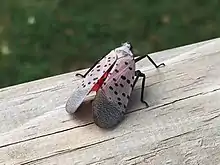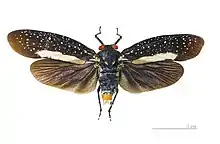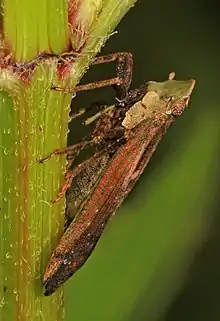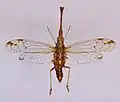Fulgoridae
The family Fulgoridae is a large group of hemipteran insects, especially abundant and diverse in the tropics, containing over 125 genera worldwide. They are mostly of moderate to large size, many with a superficial resemblance to Lepidoptera due to their brilliant and varied coloration. Various genera and species (especially the genera Fulgora and Pyrops) are sometimes referred to as lanternflies or lanthorn flies, though they do not emit light.
| Fulgoridae | |
|---|---|
 | |
| Pyrops candelaria | |
| Scientific classification | |
| Domain: | Eukaryota |
| Kingdom: | Animalia |
| Phylum: | Arthropoda |
| Class: | Insecta |
| Order: | Hemiptera |
| Suborder: | Auchenorrhyncha |
| Infraorder: | Fulgoromorpha |
| Superfamily: | Fulgoroidea |
| Family: | Fulgoridae Latreille, 1807 |
| Subfamilies | |
|
See text | |
The head of some species is produced into a hollow process, resembling a snout, which is sometimes inflated and nearly as large as the body of the insect, sometimes elongated, narrow and apically upturned. It was believed, mainly on the authority of Maria Sibylla Merian, that this process, the so-called lantern, was luminous at night in the living insect. Carl Linnaeus adopted the statement without question and coined a number of specific names, such as laternaria, phosphorea and candelaria to illustrate the supposed fact, and thus propagated the myth.
Taxonomy
Metcalf in 1938,[1] as amended in 1947,[2] recognized five subfamilies (Amyclinae, Aphaeninae, Fulgorinae, Phenacinae, and Poiocerinae) and twelve tribes in the Fulgoridae. By 1963 Lallemand had divided the Fulgoridae into eight subfamilies (Amyclinae, Aphaeninae, Enchophorinae, Fulgorinae, Phenacinae, Poiocerinae, Xosopharinae and Zanninae) and eleven tribes.[3] This classification was generally accepted.[4][5]
However, in 2008 Julie Urban's molecular analysis in her dissertation[6] showed that a significant revamping of fulgorid subfamilies and tribes would be necessary, as the morphological analysis by itself did not take into account the complexity of fulgorid evolution. Her work was recapitulated in 2009 with Jason Cryan.[5] The Zanninae may not even be in the Fulgoridae.[5]
Subfamilies and selected genera





_(8350745330).jpg.webp)
The NCBI[7] and the Hemiptera Database currently include to the following sub-families and genera (lists complete if subfamily not linked):
- Amyclinae (Central America, Africa, Australia) - selected genera:
- Alcathous Stål, 1863
- Amycle Stål, 1861
- Aphaeninae
- Aphaena Guérin-Méneville, 1834[8] (India, China, Indo-China)
- Kalidasa (Indo-China)
- Lycorma (Indo-China)
- Neolieftinckana Lallemand, 1963 (PNG)
- Omalocephala Spinola, 1839[9]
- Penthicodes (Indo-China)
- Scamandra Stål, 1863 (Malesia)
- Dichopterinae Melichar, 1912
- Cladodiptera Spinola, 1839 (South America)
- Dichoptera Spinola, 1839 (type genus - Asia)
- Dorysarthrus Puton, 1895
- Protachilus Fennah, 1944
- Enchophorinae Haupt, 1929 (S. America, Madagascar)
- Artacie Stål, 1866
- Belbina Stål, 1863
- Chilobia Stål, 1863
- Enchophora Spinola, 1839
- Enhydria Walker, 1858
- Villala Goemans & O'Brien, 2005
- Fulgorinae
- Aphrodisias Kirkaldy, 1906[10] (Central America)
- Cathedra Kirkaldy, 1903 (monotypic, S. America)
- Fulgora Linné, 1767 (tropical Americas)
- Odontoptera Carreno, 1841 (tropical Americas)
- Pyrops Spinola, 1839 (tropical Asia)
- Saiva Distant, 1906 (India, Indo-China, Malesia)
- Lyncidinae Schmidt, 1915 (southern Africa)
- Lyncides Stål, 1866
- Risius Stål, 1859
- Phenacinae (Central and South America)
- Cerogenes Horváth, 1909
- Menenia Stål, 1866
- Phenax Germar, 1833
- Pterodictya Burmeister, 1835
- Poiocerinae
- Alphina Stål, 1863
- Calyptoproctus Spinola, 1839 (Americas)
- Cyrpoptus Stål, 1862
- Lystra Fabricius, 1803 (central & southern America)
- Poblicia Stål, 1866 (N. America)
- Polydictya Guérin-Méneville, 1844 (South-East Asia:[11] Indo-China, Malesia)
- Poiocera De Laporte, 1832
- Scaralis Stål, 1863
- Strongylodematinae Fennah, 1962 (southern Africa)
- Xosopharinae Metcalf, 1947 (Africa, Australia)
- Eningia Walker, 1858
- Eurinopsyche Kirkaldy, 1906
- Mantosyna Stål, 1869
- Rentinus Metcalf, 1947
- Xosophara Kirkaldy, 1904
- Zanninae Metcalf, 1938
- Zanna Kirkaldy, 1902 (Africa, Asia)
- Fulgoridae incertae sedis
- Amdewana Nast, 1951 (neotropical)
- Amerzanna O'Brien, 1991
- Flatolystra Nast, 1950 (south America)
- Fulgoricesa Koçak & Kemal, 2010 (synonym: Weyrauchia)
- Neocynthus Nast, 1950 (South America)
- Pyrgoteles Gerstaecker, 1873 (Africa)
- Sinuala O'Brien, 1991 (3 spp., Central America)
- Stalubra O'Brien, 1991 (South America)
Notes:
- Laternaria is a nomen nudum of Pyrops
- Pyrilla Stål, 1859 is now placed in the Lophopidae
- The type species of genus Apossoda, A. togoensis Schmidt, 1911 is now placed as Pyrgoteles togoensis (Schmidt, 1911)[12]
Gallery

.jpg.webp)
 Fulgorinae: Odontoptera carrenoi
Fulgorinae: Odontoptera carrenoi
 Phenacinae: Pterodictya reticularis
Phenacinae: Pterodictya reticularis Poiocerinae: Cyrpoptus sp. (North America)
Poiocerinae: Cyrpoptus sp. (North America) Calyptoproctus stigma
Calyptoproctus stigma Pibrocha egregia
Pibrocha egregia.jpg.webp) Xosopharinae: Rentinus dilatatus
Xosopharinae: Rentinus dilatatus
References
- Metcalf, Zeno Payne (1938). "The Fulgorina of Barro Colorado and other parts of Panama". Bulletin of the Museum of Comparative Zoology. 82 (5): 277–423.
- Metcalf, Zeno Payne (1947). "Fulgoridae". General catalogue of the Hemiptera, Fascicle IV Fulgoroidea, Part 9. Northampton, Massachusetts: Smith College.
- Lallemand, Victor (1963). "Revision des Fulgoridae (Homoptera). Deuxième Partie. Faunes Asiatique et Australienne". Mémoires de l'Institut Royal des Sciences Naturelles de Belgique. 2nd series. 75: 1–99. and the material there cited.
- Liang, Ai-Ping (1995). "Taxonomic changes in oriental Fulgoroidea (Hemiptera: Fulgoromorpha)". Journal of the New York Entomological Society. 103 (2): 162–164. JSTOR 25010151.
- Urban, Julie M.; Cryan, Jason R. (2009). "Entomologically famous, evolutionarily unexplored: the first phylogeny of the lanternfly family Fulgoridae (Insecta: Hemiptera: Fulgoroidea)". Molecular Phylogenetics & Evolution. 50 (3): 471–484. doi:10.1016/j.ympev.2008.12.004. PMID 19118634.
- Urban, Julie M. (2008). A Phylogenetic Investigation of the Planthopper Superfamily Fulgoroidea (Insecta: Hemiptera) with Emphasis on the Family Fulgoridae (Ph.D. thesis). Department of Biological Sciences, University at Albany.
- NCBI Taxonomy browser: Fulgoridae (retrieved 14 November 2017)
- FLOW: Aphaena
- Hemiptera Databases FLOW: Omalocephala (retrieved 14/11/2017)
- Hemiptera Databases FLOW: Aphrodisias (retrieved 20/11/2017)
- Constant J (2010) A new species of Polydictya from Lombok (Hemiptera: Fulgoromorpha: Fulgoridae). Nouvelle Revue d'Entomologie 56 (2): 155–162.
- Catalogue of Life: 2011 Annual Checklist (retrieved 26 June 2018)
Sources
- T. Porion, 1994 - Fulgoridae 1. Illustrated Catalogue of the American Fauna Archived 2017-10-18 at the Wayback Machine, Sciences Nat, Venette, 72 pages, 14 plates in colours
- T. Porion & P. Bleuzen, 2004 - Fulgoridae 1. Supplement 1. New Neotropical Fulgoridae Archived 2016-03-05 at the Wayback Machine, Hillside Books, Canterbury, 22 pages, 4 plates in colours
- T. Porion & S. Nagai, 1996 - Fulgoridae 2. Illustrated Catalogue of the Asian and Australian Fauna Archived 2012-03-17 at the Wayback Machine, Sciences Nat, Venette, 80 p., 20 plates in colours (Suppl. 1 Archived 2012-03-17 at the Wayback Machine, Suppl. 2 Archived 2016-03-05 at the Wayback Machine)
External links
 Data related to Fulgoridae at Wikispecies
Data related to Fulgoridae at Wikispecies Media related to Fulgoridae at Wikimedia Commons
Media related to Fulgoridae at Wikimedia Commons- "North American Fulgoridae". College of Agriculture & Natural Resources, University of Delaware. Archived from the original on 2013-06-16. Retrieved 2014-01-22.
- How to Make Homemade Lantern Fly Spray?
- "Southeast Asia: Fulgoridae of Thailand, illustrations". S.E.A. Connections. Archived from the original on 26 January 2011.